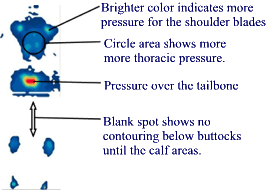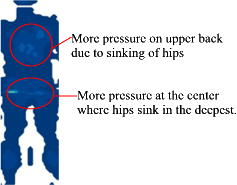Mattress Rating
Please note: The following criteria and procedures were derived from the former Beds.org management. With our new ownership and management change over, there will be some changes will be taking place over the next months, but the overall techniques employed to derive accurate pressure mapping will remain the same.
We use a very methodical system to evaluate and eventually decide if a particular mattress or bed set meets our high level of standards. This way you can know whether the mattress you will be buying or sleeping on during your hotel stay will provide you with the optimal support and comfort your body needs. This system has been reviewed and evaluated by our medical team. If a mattress passes our top-level inspection process, it will be certified with our gold seal of excellence. Below is an outline of the Beds.org medical evaluation process for each mattress:
Pressure Mapping:
Pressure mapping allows our expert team to be able to see how well a mattress contours to the body. A good contouring effect will provide your spine with better support of its natural curvature, as well as help disburse pressure across the whole of the body so no individual joint will take the brunt of the body's weight. Our medical team has been trained to read these scans much in the same way an MRI is read. They look for abnormalities in pressure distribution, as well as overall distribution of body weight.

The picture on the left is a pressure mapping scan of the body on a mattress that has been gold certified by our expert team. You will note that the body is well outlined, indicating that most of the body is pressing against the mattress and therefore being contoured very effectively. Of course, we always stress that you can place the sensitivity level of the pressure mapping software to a much higher level and you would see contouring that is not reflective of any significance. This is why we use the same setting for each test and we also check our calibration each time against our two standardized contraindicated surfaces. These surfaces include a hard surface test and a soft "hammock like" test as noted below. You will also notice a uniform color distribution that indicates a more even distribution of pressure throughout the body. Our expert team reads these color differences in numeric values and have a formula for acceptable and not acceptable levels of pressure changes throughout the mattress.
![]()
The pressure line graph above represents more pressure to right and less pressure to the left.
Pressure Map comparisons
A hard surface:
 |
As you can see from the picture to the left, this person has been placed on a hard surface, in this case the floor. The floor does not have the ability to contour, so the areas that stick out further will receive more pressure. This is illustrated with a brighter color that you will see corresponds with the color chart below. Of course, you will also notice that there is a lot more areas of the body where there is no color at all, representing virtually no pressure over these areas. This explains why in certain back pain situations a person feels like lying on the floor is more supportive, however, it is too much compression to these areas and not enough support to the rest of the spine for long term sleep positioning. |
A normal mattress with a dip in the center:
 |
As you can see from the picture on the left, this person has been placed on a more contouring surface, but this surface has a dip in the center. Therefore, the hips are sinking in further and especially the left in this case, receives more pressure. The upper back also receives more pressure from the compensating position of the lumbar spine, which has less mattress contouring from the resulting hip un-leveling and does not allow for the proper disbursement of pressure more evenly up the spinal column. |
 Tekscan's innovative pressure mapping technology and proprietary software enables our medical team to view a 3 dimensional picture for a better perspective. You will notice in the picture of the upper torso to the left, that Tekscan's pressure mapping provides our medical team with a 3 dimensional picture that can show clearly where the weight of the iliac crest portion of the pelvis sinks into the mattress deeper to provide spinal contouring at the lower back curvature. This image came from a mattress that our medical team approved and certified. As you can see the from the picture above, the colors are more uniform and the depth of contouring falls in line with the normal lordotic curve of the lumbar spine. As you would expect from a good quality mattress, the upper curvature is longer and slopes more gradually. While the 3D imaging is only an added tool for visualization, it does help demonstrate and validate the use of pressure mapping for discerning the ability this mattress to contour and therefore, support and disburse pressure more evenly across the body.
Tekscan's innovative pressure mapping technology and proprietary software enables our medical team to view a 3 dimensional picture for a better perspective. You will notice in the picture of the upper torso to the left, that Tekscan's pressure mapping provides our medical team with a 3 dimensional picture that can show clearly where the weight of the iliac crest portion of the pelvis sinks into the mattress deeper to provide spinal contouring at the lower back curvature. This image came from a mattress that our medical team approved and certified. As you can see the from the picture above, the colors are more uniform and the depth of contouring falls in line with the normal lordotic curve of the lumbar spine. As you would expect from a good quality mattress, the upper curvature is longer and slopes more gradually. While the 3D imaging is only an added tool for visualization, it does help demonstrate and validate the use of pressure mapping for discerning the ability this mattress to contour and therefore, support and disburse pressure more evenly across the body.
Linear Measurements:
Our medical team also evaluates mattresses to detect any sagging or uneven surfaces. They use plumb lines and tape measurements at various points to detect any abnormalities.
Mattress Component Investigation:
All mattress that are candidates for our certification process by our expert team must undergo a thorough component check that will give them the ability to see the quality of materials used to make the mattress and help qualify the use of such materials. In this process, any materials that are found to be substandard will prohibit a mattress from obtaining a Beds.org certification.
Independent Subjective Opinions
While Beds.org prides itself on providing reproducible objective results, we have listened to feedback from the public and are now having each mattress undergo an independent test trial. This trial uses 4-6 unbiased subjects that are able to test the mattress and fill out a survey of the mattress comfort, support and likeability factor. In this way you can rest easier knowing that you will not be purchasing a mattress without hearing what other user responses were. We allow each evaluator to rate the mattress on a 1-5 star rating for each category and we then factor a total score. We emphasize that our test subjects are not trained in the field of mattresses and therefore we have set-up simple guidelines for determining the difference between a 1 and a 5. For instance, when determining edge support, we let them know in advance that a 1 would only be given in an extreme instance the bed not being able to hold the weight of a person on the edge so that they would fall off. Where as we also let them know that if it seems stable when rolling onto the edge, a 5 would be expected. Numbers in between would be used when there is a problem, but not severe enough to warrant a 1 on 1-5 scale. We realize that this may allow our testers to be a bit more lenient in the grading system, but we strongly believe that this is the most reliable way to grade these mattresses and, therefore, give the public the most consistent subjective opinions across the board for every mattress we test.



